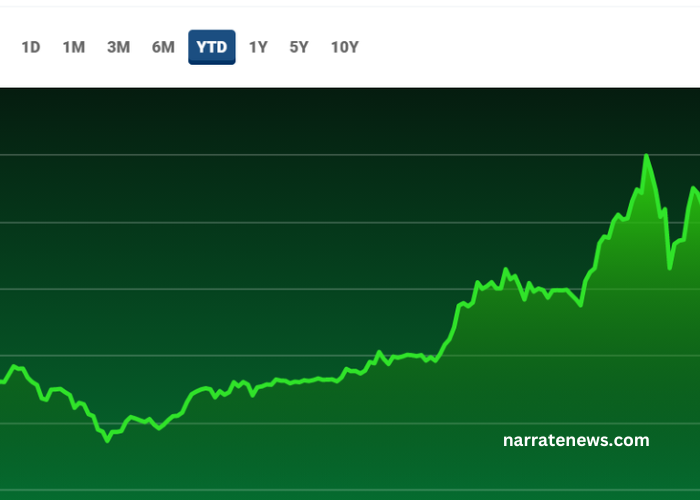
A Comprehensive Guide to Analyzing Tesla Stock Performance
Tesla Inc. stands as a towering figure in the realm of electric vehicles (EVs), renewable energy, and disruptive technology. As one of the most talked-about stocks in the financial markets, analyzing Tesla’s performance requires a nuanced understanding of various factors, including industry trends, company fundamentals, and market sentiment. In this guide, we’ll delve into the intricacies of Tesla stock analysis, equipping investors with the knowledge and tools needed to make informed decisions in the dynamic world of stock investing.
Tesla Stock Performance
Understanding Tesla and its Market Position
The Rise of Tesla:
Tesla’s journey from a niche electric car startup to a global powerhouse has been nothing short of remarkable. Founded by Elon Musk in 2003, Tesla has disrupted the automotive industry with its innovative electric vehicles, energy products, and ambitious vision for the future.
Market Dynamics and Industry Trends:
Analyzing Tesla’s stock performance requires a keen understanding of broader market dynamics and industry trends shaping the automotive and renewable energy sectors. Factors such as EV adoption rates, regulatory policies, technological advancements, and competition play a significant role in influencing Tesla’s trajectory.
Tesla’s Competitive Landscape:
While Tesla leads the charge in the EV market, it faces competition from traditional automakers and new entrants vying for market share. Analyzing Tesla’s competitive positioning, market share, and technological advantages is essential for gauging its long-term growth prospects.
Key Metrics and Financial Performance
Revenue Growth and Sales Volume:
Monitoring Tesla’s revenue growth and vehicle delivery numbers provides insights into the company’s sales trajectory and market demand for its products. Quarterly earnings reports and production figures are key metrics to track for assessing Tesla’s financial health.
Profitability and Margins:
Despite Tesla’s rapid revenue growth, profitability has been a point of contention for investors. Analyzing Tesla’s gross margins, operating expenses, and net income is critical for evaluating its ability to generate sustainable profits amid ongoing investments in research, development, and expansion.
Cash Flow and Liquidity:
Cash flow analysis is crucial for understanding Tesla’s financial stability and liquidity position. Monitoring cash flow from operations, capital expenditures, and free cash flow provides insights into Tesla’s ability to fund its growth initiatives, service debt obligations, and weather economic downturns.
Assessing Growth Opportunities and Risks
Expansion into New Markets:
Tesla’s expansion into new markets, including China and Europe, presents significant growth opportunities. Analyzing sales trends, regulatory developments, and market reception in these regions is essential for assessing Tesla’s international growth strategy.
Technological Innovation and Product Pipeline:
Tesla’s success hinges on its ability to innovate and develop groundbreaking technologies that differentiate its products from competitors. Monitoring developments in autonomous driving, battery technology, and energy storage solutions provides insights into Tesla’s long-term competitive advantage.
Regulatory and Environmental Factors:
Regulatory policies and environmental initiatives play a pivotal role in shaping Tesla’s operating environment. Analyzing government incentives, emission standards, and regulatory compliance is crucial for understanding the regulatory risks and opportunities facing Tesla.
Market Sentiment and Investor Behavior
Social Media and Investor Sentiment:
Social media platforms and online forums often serve as hubs for discussions and debates about Tesla stock. Analyzing sentiment indicators, such as online mentions, sentiment scores, and message board activity, provides insights into investor sentiment and market perception of Tesla.
Analyst Recommendations and Price Targets:
Wall Street analysts frequently provide recommendations and price targets for Tesla stock based on their analysis of company fundamentals and market trends. Monitoring analyst reports, earnings forecasts, and consensus estimates can help investors gauge market expectations and sentiment.
Short Interest and Institutional Ownership:
Short interest and institutional ownership data offer insights into investor sentiment and market dynamics surrounding Tesla stock. Tracking changes in short interest levels, institutional buying and selling activity, and insider transactions can provide clues about market sentiment and potential price movements.
Analytical Tools and Techniques
Fundamental Analysis:
Fundamental analysis involves evaluating Tesla’s financial statements, business model, and competitive positioning to determine its intrinsic value. Key metrics such as price-to-earnings ratio, price-to-sales ratio, and return on equity are used to assess Tesla’s valuation and investment potential.
Technical Analysis:
Technical analysis involves studying Tesla’s stock price movements and trading patterns to identify trends and potential entry or exit points. Charting techniques, moving averages, and technical indicators such as Relative Strength Index (RSI) and Moving Average Convergence Divergence (MACD) are commonly used by technical analysts.
Quantitative Analysis:
Quantitative analysis involves using mathematical models and statistical methods to analyze Tesla’s stock performance and predict future price movements. Regression analysis, Monte Carlo simulations, and machine learning algorithms can be applied to identify patterns and relationships in Tesla’s historical data.
Conclusion: Navigating the Road Ahead
As investors navigate the ever-changing landscape of financial markets, analyzing Tesla’s stock performance requires a multifaceted approach that incorporates industry knowledge, financial acumen, and analytical rigor. By understanding Tesla’s market position, assessing key metrics and financial performance, evaluating growth opportunities and risks, and utilizing analytical tools and techniques, investors can make informed decisions that align with their investment objectives and risk tolerance. With a comprehensive understanding of Tesla’s stock performance and a disciplined approach to analysis, investors can position themselves for success in the dynamic world of stock investing.
In conclusion, decoding Tesla’s stock performance requires a deep dive into various factors, including industry trends, financial metrics, growth prospects, and investor sentiment. By employing a structured approach to analysis and leveraging the right tools and techniques, investors can gain valuable insights into Tesla’s performance and make informed investment decisions that drive long-term value creation.


